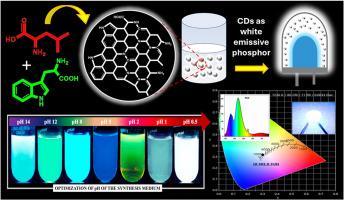设计用于冷白光LED的ph功能化碳点白光发光荧光粉
IF 11.6
2区 材料科学
Q1 CHEMISTRY, PHYSICAL
引用次数: 0
摘要
碳点(cd)是一种零维富碳纳米粒子,由于量子约束效应而表现出很好的光致发光特性。此外,它们的易合成、低毒性和可定制性也受到了相当大的关注。在当今照明技术先进的时代,实现单一的白光发光CDs作为高效率的白光荧光粉是必不可少的,因为它们在发光二极管(led)中的应用具有成本效益。通过各种稀土掺杂荧光粉产生白光发射;它们的合成过程繁琐,成本高,潜在的毒性给现实世界的应用带来了挑战。为此,我们探索了在pH辅助条件下,由l-亮氨酸和l-色氨酸一步水热合成白光发光CDs的方法。它们具有较宽的光致发光发射光谱,在450nm处达到最大强度。将这些CDs嵌入聚乙烯醇(PVA)基质中,形成颜色转换荧光粉层,防止聚集引起的自猝灭,随后将其集成到365 nm UV LED上。制备的CDs薄膜在室温储存条件下稳定达300天,衰变时间较长,为18.6 ns。有趣的是,该材料的显色指数(CRI)高达86%,呈现出冷白光发射,其色度坐标为(0.302,0.318),相关色温(CCT)为7236 K,位于普朗克轨迹曲线附近。这些结果突出了合成cd作为高效,无金属荧光粉的潜力,用于开发具有成本效益的冷白光led。本文章由计算机程序翻译,如有差异,请以英文原文为准。

Designing pH-Functionalized carbon dots as white light emitting phosphor for cool white LED application
Carbon Dots (CDs) are zero dimensional carbon rich nanoparticles that exhibit promising photoluminescent properties due to quantum confinement effect. Furthermore, their ease of synthesis, reduced toxicity and customizable properties have gained considerable focus. In the present era of advanced lighting technology, achieving single white light emitting CDs which could serve as white phosphors with high efficiency is essential due to their cost-effective application in Light Emitting Diodes (LEDs). Though various rare earth doped phosphors produce white light emission; their tedious synthetic process, high cost, potential toxicity imposes challenges in real world applications. In response to this, we explored reproducible one-step hydrothermal synthesis of white light emitting CDs from l-leucine and l-tryptophan under pH assisted reaction conditions. They exhibited wide photoluminescence emission spectrum reaching maximum intensity at 450 nm. These CDs were embedded into polyvinyl alcohol (PVA) matrix to attain colour conversion phosphor layer, which prevents aggregation induced self-quenching and were subsequently incorporated onto 365 nm UV LED. The fabricated CDs film was stable up to 300 days under room temperature storage conditions with a longer decay time of 18.6 ns. Intriguingly, a high Colour Rendering Index (CRI) of 86 % was achieved, exhibiting cool white light emission characterized by chromaticity coordinates of (0.302, 0.318) and Correlated Colour Temperature (CCT) of 7236 K positioned near the Planckian locus curve. These results highlight the potential of the synthesized CDs as efficient, metal-free phosphors for the development of cost effective cool white LEDs.
求助全文
通过发布文献求助,成功后即可免费获取论文全文。
去求助
来源期刊

Carbon
工程技术-材料科学:综合
CiteScore
20.80
自引率
7.30%
发文量
0
审稿时长
23 days
期刊介绍:
The journal Carbon is an international multidisciplinary forum for communicating scientific advances in the field of carbon materials. It reports new findings related to the formation, structure, properties, behaviors, and technological applications of carbons. Carbons are a broad class of ordered or disordered solid phases composed primarily of elemental carbon, including but not limited to carbon black, carbon fibers and filaments, carbon nanotubes, diamond and diamond-like carbon, fullerenes, glassy carbon, graphite, graphene, graphene-oxide, porous carbons, pyrolytic carbon, and other sp2 and non-sp2 hybridized carbon systems. Carbon is the companion title to the open access journal Carbon Trends. Relevant application areas for carbon materials include biology and medicine, catalysis, electronic, optoelectronic, spintronic, high-frequency, and photonic devices, energy storage and conversion systems, environmental applications and water treatment, smart materials and systems, and structural and thermal applications.
 求助内容:
求助内容: 应助结果提醒方式:
应助结果提醒方式:


